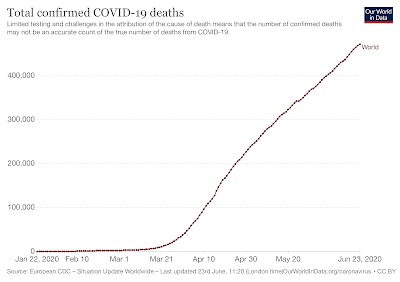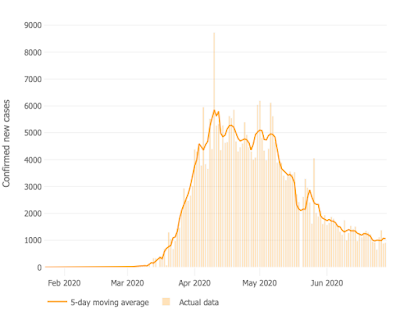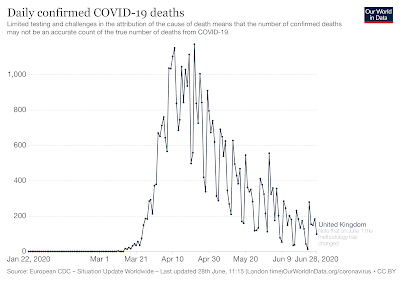.
Viruses don’t hibernate
Over here at least it’s a bit more of a struggle for the coronavirus right now. It’s harder for it to jump from person to person and find another host. For one thing, some people will have antibodies (though not that many) and with the summer and the heatwaves we have experienced lately there is far more immune boosting Vitamin D around. Peoples behaviour has changed with varying degrees of distancing becoming the norm and lots of activity still suppressed.
And of course, it does tend to fade away in the summer anyway.
Today in the UK there were 115 recorded deaths, which though sad, represent progress, and still 689 cases from the 133,000 tests done. Of those being tested in the community, that is those who think they might have an infection or in contact with a case, about 1% are testing positive.
In the US there are some significant state wide spikes despite the summer heat, the number of
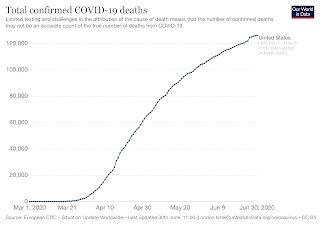 |
| Climbing US Deaths |
daily cases is rising, and deaths running at about 500 a day. It looks like Donald Trumps early throw away comment (aren’t they all) that it would be an achievement to have less than 200,000 American deaths underestimated the problem which has been compounded by terrible political leadership and poor public services in an increasingly fragile USA.
Spikes of infection are evident all over the globe in countries past the worst of the outbreaks and are everywhere testing the public services in a test of what we can, in this modern age, term our level of civilisation.
Elastic social distancing
Guidance has changed and we are now advised to keep ONE metre away from others. This will make a huge difference to business, especially the hospitality sector, but still serves as an illustration of how simple commands from above are divorced from day to day reality of living on the ground.
In some situations, like meetings outside in the sun and in localities where there have been no outbreaks it hardly seems to matter, the risks of infection are so low.
 |
| UK social distancing (BBC) |
Indeed, if there are no spikes after the escapades on Bournemouth beach (see pic) then there will have to be some serious head scratching.
I have seen no reports of spikes after the Black Lives Matter protests, or the previous mass gatherings on the beaches in the May bank holidays, or after illegal raves in Manchester. If there really are no spikes, then a bit more nuance is needed in advice from the centre.
Yet indoors, and in contact with those who work with others two meters may not be far enough.
Certain occupations, like workers in meat processing plants which are kept cold, and in other roles where distancing is not possible, and working conditions poor, create particular risks for creating local outbreaks. One metre might not be enough if you are next to a fellow worker all day.
It’s very clear that COVID19 does not like it outdoors in the summer, it lasts just
minutes in the sun and
it spreads far more rapidly indoors. The great outdoors is the safest place to be.
In other words, social distancing depends on the precise experience you are having and relies on common sense the government clearly think is lacking in the general population. Kettles and black I might suggest!
Localism needs intensive care
The stubborn rate of infection
in Leicester is not explained by any one particular event, and is more likely to be due to a mixture of the local conditions and population. Perhaps the thriving fast food business with its congregations of customers might be maintaining the level of infection, as well as crowded conditions in the city’s garment industry where low pay results in low paid employees working through illnesses due to lack of sufficient sick pay.
One thing is evident, and again that is the dead hand of centralisation. It seems the mayor of Leicester had little more information than you or I up till the night before government announcements requiring prolongation of the restrictions. This is despite this being a local affair needing local infrastructure which has been dissolved by political diktat over the last few decades. The mind boggles.
One of the positive messages, or warnings, the virus has offered is that we need to rebuild the local infrastructure essential to deal with our many of the challenges of the modern world. All around the world we see countries with decent local infrastructure coping better.
There is now a scientific case for devolved regional powers and strengthened local governments.
COVID19 and the brain
It seems the virus is more interesting than we thought. Not only are there concerns about the
complicated recovery experienced by many patients hospitalised by COVID19, but the virus is clearly able to hit a number of organs
including the brain. ACE receptors, its target cell, are widespread in body.
It seems that neurological symptoms vary from mild confusion to those consequent on full blown infections of the brain and strokes and
might be more common than we think.
Post traumatic stress is understandably common amongst those who needed intensive care, but for some there are other neurological consequences too.This is likely to explain why many people are complaining of protracted recoveries involving fuzzy thinking, poor concentration, mood problems, muscular pains and fatigue, amongst other things.
In some unlucky cases it might also trigger diabetes. It is clear that the NHS will continue to need increased funding to help people through the rehabilitation phase to full recovery.
COVID19 at work….
Images from electron microscopes in my lifetime, have lit up the world of science and revolutionised our connection with all things tiny.
This image shows what COVID19 gets up to at the cellular level. It hijacks the protein making machinery of its target cells and sets them to work making what are called filopodia (latin = filament legs) and with which they infect nearby cells.
Science fiction seems so dull compared to what goes on at this “science fact” microscopic level!
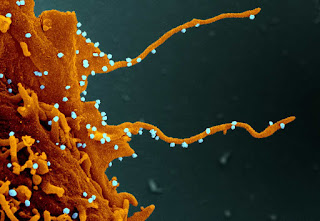 |
|
Infected cells produce tentacles known formally as filopodia (orange) extending out from the cell surface to enable budding of viral particles (blue) and infection of nearby cells.
Dr. Elizabeth Fischer, NIAID/NIH
|
Understanding exactly how the virus works, the genes it uses to take over cells, and how it spreads between them offers the potential of putting spanners in their works and coming up with an antiviral which would hit them without affecting other cellular machinery. No news on this yet.
Treatments
At least there is one treatment option which seems not to have fallen on the appropriate hurdles of well conducted trials. That is the old fashioned, readily available and cheap steroid dexamethasone. Through its blunderbuss anti-inflammatory actions, it significantly reduces the death rates in those with more severe infections needing admitted to Intensive Care Units. For those ventilated, mortality dropped from 47% to 29% in the treated group and that is good news.
This will now become standard treatment in this setting.
The timing of treatment is important as too early it might do more harm than good, and too late will not work so well, so no Donald, don’t add this to the less than useless hydroxychloroquine.
The USA have
bought up the worlds supply of the next few months of Remdesivir production from the manufacturers Gilead. The drug has modest anti viral effects and hastens recovery by a few days though without evidence of saving lives.
This manifestation of “America First” policy in action raises more issues that it solves. Will the UK government buy generic products from India and elsewhere in defiance of long upheld
respect for intellectual property rights of drug companies? Given that the virus doesn’t respect borders, how will the US help solve the global crisis? What happens when a vaccine is developed?
We are really all in this together, one big global community, and the US administration is clearly putting November election success before any semblance of international co-operation. Disappointment is dulled by the complete lack of surprise.
Vaccines are still in the pipeline but might raise some interesting issues as they will not work so well in the older people most at
risk from the infection. This is not entirely new. Like with influenza immunising children might protect their grandparents more that vaccinating the grandparents themselves; I suspect the anti-vaxxers will have a field day with this.
Testing testing….
In an ideal world inevitable local outbreaks will be dealt with promptly. Potential “super-spreaders”, those 10% of cases who cause 90% of infections will be supported to stay at home on a decent level of pay, their contacts traced and tested and relevant isolation or quarantine monitored and supported. Meanwhile the unaffected continue to get back to normal.
Ideally.
Yet our Testing and Tracing, said to be a vital for this to work, are both continually beset with problems. With our shiny NHS tracing App ditched (along with the millions it cost), and replacements in what seems to be a very long pipeline, my mind boggles at the possibility of what will go wrong next?
Even with the money (£108million) flowing to the private sector tracing teams, local health protection teams have traced nearly eight times more contacts (77,642) that the national call centres (9997), and at a tiny fraction of the cost. This is because they deal with what are called ‘complex’ cases, which it turns out appear, predictably, to be most of them.
This is not surprising. In the middle of lockdown it is easy to know who you have been in close contact with. Now, after a weekend on the beach and a couple of shopping trips as well as potentially, school trips, the answer to the question “Who have you been in close contact with?” could be a good few thousand people. Outside of lockdown, all cases are complex. That is where the App is meant to come in.
More worrying still, up till the 10th June, only 14,000 of the 33,000 people reported by the ONS as infected have been traced at all, so the foundations of our response to the virus are very shaky indeed right now.
 |
| Thanks to Steve Bell |
According to “The Science”, that is, the Governments SAGE group, 80% of contacts of cases needing to isolate to quell outbreaks.This is clearly not even close to being achieved.
What happens next?
In other words, there is a possibility we are going to struggle to contain any further significant outbreaks, but might be ready to do so at some time deep into the winter. Poor over-centralised dogma driven decision making is exacting a high price and lessons seem not to be learned. Nothing new there!
Yet might we be lucky? With social distancing so often breaking down and mass events taking place, there are some big epidemiological experiments going on. If there are no spikes reported as a consequence of big crowds in the summer, new guidance might be needed. Thinking must evolve faster that the virus.
With the pandemic surging in the southern hemisphere and increasing in the US, it might suggest we are in for a resurgence up here in the north in the winter. Various other spikes in the north also demonstrate that Sars-Cov2-19 is here to stay.
Backward forward thinking
Thats not a typo! We are simultaneously clever and stupid.
In China (in epidemiological terms just around the corner) nasal swabs from pigs and workers from pig factories show that novel and dangerous
viruses continue to be generated by factory farming and released into the general population via the workers. A new variant of flu in this case. Excellent monitoring, yet how insane is it not to tackle intensive farming methods which generated the new strain in the first place.
Perhaps they think investment in viral labs in Wuhan and elsewhere might keep us on top of this problem, yet Sars-Cov2-19 has proved them wrong.
While the world deals with the human and financial cost of the coronavirus, the profits of Big Farmer are left untouched and often untaxed despite their leading role in generating many of our new viral cohabitees.
It seems to me that the global spread of infections, rocketing levels of obesity and ill health, environmental destruction and species loss are tied together under the umbrella of metastatic “fast farming” and the health destroying edible food like substances it produces.
We are, literally, sowing the seeds of our destruction as we speak.
Good Health
As always, and with every post, I am reminded that this little virus has magnified the critical importance of lifestyle. Good food from good farms with good soil, fresh air, exercise, sun and vitamin D are critical to enable our defences to fight off Sars-Cov2-19, as well as basic hygiene, a bit of luck, and good science.
Moments of joy and happiness can keep us going through more worrying times and these need to be cherished when created or encountered. Enjoy the summer!
